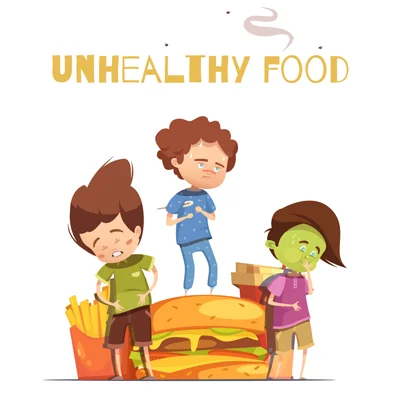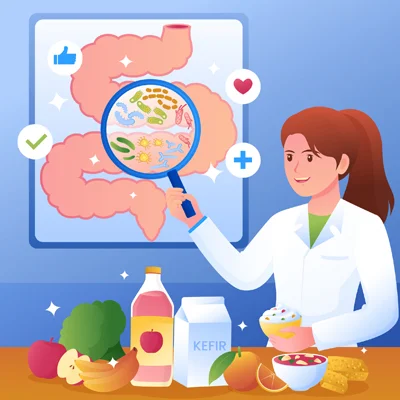Foodborne Diseases: Types, Symptoms, Causes & Prevention also known as foodborne illnesses or food poisoning, are health conditions caused by the consumption of food or beverages contaminated with harmful pathogens such as bacteria, viruses, parasites, or chemical substances. These contaminants can lead to various symptoms and illnesses when ingested. Foodborne diseases can range from mild discomfort to severe and sometimes life-threatening conditions.
Common pathogens responsible for foodborne diseases include Salmonella, E. coli, Campylobacter, Listeria, norovirus, and many others. Contaminated food can spread these pathogens to consumers through improper food handling, storage, or preparation, as well as through the consumption of undercooked or raw foods.
Symptoms of foodborne diseases can vary widely and may include nausea, vomiting, diarrhea, abdominal pain, fever, and other flu-like symptoms. The severity and duration of the illness depend on the specific pathogen involved, the individual’s health, and the amount of contaminated food or drink consumed.
Preventing foodborne diseases involves practicing proper food safety measures, including cooking food to safe temperatures, avoiding cross-contamination, washing hands and food-contact surfaces thoroughly, and ensuring that food is stored at appropriate temperatures. Regulatory agencies and health organizations also play a critical role in monitoring and regulating food safety standards to reduce the incidence of foodborne illnesses.
Types of Foodborne Diseases
Foodborne diseases can be caused by a variety of pathogens, including bacteria, viruses, parasites, and sometimes chemical agents.
Here are some of the most common types of foodborne diseases:
- Salmonellosis: Caused by the Salmonella bacteria, this infection leads to symptoms such as diarrhea, abdominal cramps, fever, and vomiting. Contaminated eggs, poultry, and unpasteurized milk are common sources.
- Escherichia coli (E. coli) Infections: E. coli can cause a range of illnesses, with the strain E. coli O157:H7 being particularly dangerous. It can lead to severe diarrhea, kidney failure, and, in some cases, death. Contaminated undercooked ground beef and raw vegetables are often sources.
- Campylobacteriosis: Infections with Campylobacter bacteria result in symptoms like diarrhea, abdominal pain, and fever. Poultry, unpasteurized milk, and contaminated water are common sources.
- Listeriosis: Caused by the Listeria monocytogenes bacterium, this disease is particularly dangerous for pregnant women, newborns, and individuals with weakened immune systems. Symptoms include fever, muscle aches, and gastrointestinal symptoms. Contaminated deli meats, soft cheeses, and raw milk can be sources.
- Norovirus Infections: Norovirus is a highly contagious virus responsible for many cases of acute gastroenteritis. Symptoms include vomiting, diarrhea, and stomach cramps. Contaminated food and water, as well as person-to-person transmission, can spread the virus.
- Hepatitis A: Hepatitis A is a viral infection that affects the liver. Symptoms can include jaundice, fatigue, and gastrointestinal symptoms. It is often transmitted through contaminated food and water.
- Clostridium botulinum (Botulism): This rare but serious disease is caused by the Clostridium botulinum bacteria and can result in paralysis and death. Improperly canned or preserved foods are potential sources.
- Toxoplasmosis: Caused by the Toxoplasma parasite, this disease can lead to flu-like symptoms, but it is particularly concerning for pregnant women as it can harm the fetus. Raw or undercooked meat, unwashed fruits and vegetables, and contact with infected cat feces are potential sources.
- Vibrio Infections: Various species of Vibrio bacteria can lead to seafood-related illnesses. These infections can result in diarrhea and, in some cases, severe wound infections from exposure to contaminated seawater.
- Staphylococcal Food Poisoning: This illness is caused by the Staphylococcus aureus bacterium, which produces a toxin that can lead to symptoms like vomiting, diarrhea, and abdominal cramps. Contaminated food, especially those left at room temperature for extended periods, is a common source.
- Ciguatera Fish Poisoning: Caused by the consumption of certain reef fish contaminated with toxins, this can result in gastrointestinal and neurological symptoms.
- Scombroid Poisoning: This results from the consumption of certain types of spoiled fish (e.g., tuna, mackerel) and can lead to symptoms resembling an allergic reaction, including skin flushing, headaches, and gastrointestinal issues.
- Chemical Contaminants: In addition to pathogens, foodborne diseases can also result from chemical contaminants, such as pesticides, food additives, and various toxins produced by molds, including aflatoxins.
Preventing foodborne diseases involves proper food handling, storage, and cooking, as well as regular handwashing and following food safety guidelines. Regulatory agencies and public health organizations work to ensure food safety and reduce the risk of foodborne illnesses.

Symptoms of Foodborne Diseases
The symptoms of foodborne diseases can vary depending on the specific pathogen or contaminant responsible for the illness, as well as individual factors like the person’s age and overall health.
However common symptoms of foodborne diseases may include:
- Gastrointestinal Symptoms:
– Diarrhea
– Nausea
– Vomiting
– Abdominal pain or cramps
– Stomach bloating
– Loss of appetite - Fever: Many foodborne illnesses can cause an elevated body temperature.
- Headache: Some foodborne pathogens can lead to headaches as a symptom.
- Muscle Aches: Muscle pain or aches can occur with certain foodborne infections.
- Dehydration: Prolonged diarrhea and vomiting can lead to dehydration, which may manifest as dry mouth, dark urine, decreased urine output, and extreme thirst.
- Fatigue: Feeling tired or weak is a common symptom of foodborne illnesses.
- Gastrointestinal Bleeding: In severe cases or with certain pathogens, gastrointestinal bleeding may occur, leading to bloody stools or vomit.
- Neurological Symptoms: Some foodborne diseases can result in neurological symptoms, such as confusion, dizziness, or even paralysis in rare cases (e.g., botulism).
- Skin Symptoms: Certain infections, like Staphylococcal food poisoning, can cause skin symptoms, including skin flushing or rashes.
- Respiratory Symptoms: In some cases, respiratory symptoms like coughing or difficulty breathing can occur.
It’s important to note that the onset, duration, and severity of these symptoms can vary widely. In mild cases of foodborne illness, symptoms may be relatively minor and short-lived, while in severe cases, they can be debilitating and lead to complications.
If you or someone you know experiences these symptoms after consuming food, especially if they are severe, persist, or are accompanied by high fever, dehydration, or blood in stool or vomit, it is essential to seek medical attention promptly. Foodborne diseases can sometimes be life-threatening, particularly in vulnerable populations such as young children, the elderly, and individuals with weakened immune systems.
Causes of Foodborne Diseases
Foodborne diseases are typically caused by various microorganisms, including bacteria, viruses, parasites, and, in some cases, chemical contaminants.
Here are the primary causes of foodborne diseases:
- Bacteria:
– Salmonella: Found in raw poultry, eggs, and dairy products.
– Escherichia coli (E. coli): Certain strains, like E. coli O157:H7, are associated with undercooked ground beef and raw produce.
– Campylobacter: Often found in raw or undercooked poultry, as well as contaminated water.
– Listeria: Can be present in deli meats, soft cheeses, and unpasteurized milk.
– Clostridium perfringens: Commonly associated with undercooked meats and poultry.
– Staphylococcus aureus: Produces toxins in foods left at room temperature.
– Clostridium botulinum: Rare but very dangerous; found in improperly canned or preserved foods. - Viruses:
– Norovirus: Highly contagious and frequently associated with contaminated food and water.
– Hepatitis A: Transmitted through contaminated food and water, as well as person-to-person contact. - Parasites:
– Toxoplasma gondii: Found in undercooked or raw meat and unwashed fruits and vegetables.
– Giardia lamblia: Typically found in contaminated water.
– Cyclospora: Associated with contaminated fruits and vegetables.
– Cryptosporidium: Often found in swimming pools and contaminated water sources. - Chemical Contaminants:
– Pesticides: Residues from agricultural chemicals on fruits and vegetables.
– Food additives: Some food additives may cause adverse reactions in sensitive individuals.
– Toxins: Certain molds produce mycotoxins, like aflatoxins, which can contaminate nuts and grains. - Heavy Metals:
– Contamination of seafood with heavy metals like mercury can lead to foodborne illnesses. - Biotoxins:
– Ciguatera toxin from certain fish, like barracuda and grouper, can cause foodborne illnesses. - Allergens:
– Some individuals may have severe allergic reactions to specific food proteins, such as peanuts, tree nuts, shellfish, and more. - Radiological Contaminants:
– Radioactive substances can potentially contaminate food following nuclear accidents or incidents.
It’s important to note that proper food handling, storage, and preparation are crucial in preventing foodborne diseases. Washing hands and surfaces, cooking food to safe temperatures, and avoiding cross-contamination are essential steps in reducing the risk of foodborne illnesses. Regulatory agencies and public health organizations also play a significant role in monitoring and regulating food safety standards to minimize the occurrence of foodborne diseases.

Prevention of Foodborne Diseases
Preventing foodborne diseases is essential to ensure the safety and well-being of individuals.
The following measures can help reduce the risk of foodborne illnesses:
- Cleanliness and Hand Hygiene:
– Wash hands thoroughly with soap and warm water for at least 20 seconds before handling food, after using the restroom, touching pets, or changing diapers.
– Keep cooking surfaces, utensils, and hands clean to prevent cross-contamination. - Safe Food Storage:
– Refrigerate perishable foods promptly (within two hours or one hour if the temperature is over 90°F or 32°C).
– Use a refrigerator thermometer to ensure the temperature stays at or below 40°F (4°C).
– Use a freezer thermometer to maintain a temperature of 0°F (-18°C) or lower.
– Store raw meat, poultry, and seafood in separate containers or plastic bags to prevent juices from contaminating other foods. - Safe Food Preparation:
– Thaw frozen foods in the refrigerator, in cold water, or in the microwave (never on the counter).
– Use a food thermometer to ensure that foods reach safe internal temperatures (e.g., poultry should reach 165°F or 74°C).
– Avoid cross-contamination by using separate cutting boards and utensils for raw and cooked foods. - Safe Food Handling:
– Avoid consuming raw or undercooked eggs, poultry, meat, and seafood.
– Keep hot foods hot (above 140°F or 60°C) and cold foods cold (below 40°F or 4°C).
– Discard food that has been left out at room temperature for more than two hours (one hour if the temperature is over 90°F or 32°C). - Avoid Raw or Unpasteurized Products:
– Avoid consuming raw or unpasteurized milk, cheese, and other dairy products.
– Be cautious with raw shellfish, such as oysters and clams. - Proper Food Sources:
– Purchase food from reputable sources and inspect it for signs of spoilage.
– Avoid foods that are past their expiration date or appear damaged. - Safe Water and Ice:
– Ensure that the water used for drinking and cooking is safe.
– Use ice from clean sources. - Safe Food Handling While Dining Out:
– When dining out, ensure that the restaurant follows proper food safety practices.
– Ask for meat to be cooked to the desired level of doneness. - Education and Awareness:
– Stay informed about food recalls and food safety practices.
– Educate yourself and others about safe food handling and storage. - Special Considerations:
– Those at higher risk of foodborne illnesses, such as pregnant women, young children, the elderly, and people with weakened immune systems, should take extra precautions and avoid certain high-risk foods. - Reporting Suspected Foodborne Illnesses:
– If you suspect you have a foodborne illness, report it to your local health department. This can help identify and address potential outbreaks. - Follow Local Food Safety Guidelines and Regulations:
– Comply with local and national food safety regulations and guidelines to ensure safe food handling and preparation.
By following these preventive measures, individuals can significantly reduce the risk of foodborne diseases and contribute to overall food safety. Public health agencies and regulatory bodies also play a crucial role in monitoring and enforcing food safety standards to protect the public.
Is foodborne a virus or bacteria?
Foodborne diseases can be caused by various microorganisms, including both viruses and bacteria, as well as parasites and other contaminants. Therefore, foodborne diseases are not limited to just one type of pathogen.
Here’s a brief breakdown of the different types of microorganisms that can cause foodborne illnesses:
- Bacteria: Many foodborne illnesses are caused by pathogenic bacteria. Examples include Salmonella, Escherichia coli (E. coli), Campylobacter, Listeria, Staphylococcus aureus, and Clostridium perfringens.
- Viruses: Certain viruses can also lead to foodborne illnesses. Common examples include norovirus and hepatitis A.
- Parasites: Parasites like Toxoplasma, Giardia, Cryptosporidium, and Cyclospora can be responsible for foodborne diseases.
- Chemical Contaminants: Some foodborne illnesses result from exposure to chemical contaminants or toxins, such as those produced by certain molds or exposure to pesticides.
The specific symptoms, severity, and treatment of foodborne diseases can vary depending on the type of pathogen involved. Proper food handling, storage, and preparation, along with food safety practices, can help reduce the risk of foodborne illnesses caused by these different types of microorganisms.
Can foodborne illness be tasted?
Foodborne illnesses themselves typically do not have a distinctive taste that would allow you to identify them solely by flavor. However, the contaminated or spoiled food that causes these illnesses can sometimes exhibit unusual or off flavors, odors, or textures, which might be noticeable if you pay close attention.
Here are a few examples:
- Spoiled Foods: Food that has gone bad due to spoilage bacteria can sometimes develop an unpleasant taste or odor. For instance, sour or rancid flavors in dairy products or a “rotten” smell in meat are indicators of spoilage. These changes may signal that consuming the food could lead to a foodborne illness.
- Certain Pathogens May Alter Taste: In some cases, food contaminated with pathogenic bacteria or other microorganisms might taste slightly different due to the metabolic byproducts they produce. However, these changes are usually subtle and not easily detectable by taste alone.
- Foodborne Toxins: Some foodborne illnesses can result from the consumption of food containing toxins produced by bacteria. These toxins don’t necessarily affect the taste of the food but can cause symptoms when ingested.
While you may not be able to reliably identify foodborne pathogens through taste, it’s essential to practice good food safety and hygiene habits, which can help prevent the consumption of contaminated food. This includes proper food storage, cooking to safe temperatures, avoiding cross-contamination, and adhering to food safety guidelines. If you suspect that food might be unsafe to eat or if it has an unusual taste or odor, it’s best to err on the side of caution and discard it rather than risking foodborne illness.
Irritable Bowel Syndrome: Types, Symptoms, Causes & Prevention
Breast Cancer: Types, Symptoms, Causes, & Prevention
Migraine: Types, Symptoms, Causes & Home Remedies
Understanding Syncope: Symptoms, Causes & Home Remedies
Freckle: Symptoms, Causes, Prevention & Need to Know
Dehydration: Symptoms, Causes, & You Should Know About
Stress: Symptoms, Causes & Prevention
Snoring: Types, Symptoms, Causes & Home Remedies
Epilepsy: Symptoms, Causes & Home Remedies
Alzheimer’s Disease: Symptoms, Causes, & Prevention
Respiratory Disease: Symptoms, Causes, Preventive & Remedies
Iodine Deficiency: Symptoms, Causes, & Home Remedies
Insomnia: Types, Symptoms, Causes & Prevention
Sunburn: Symptoms, Causes, Prevention & Home Remedies
Sore Throat, Symptoms, Causes, Prevention & Home Remedies
If you don’t like this article/post please share your feedback





